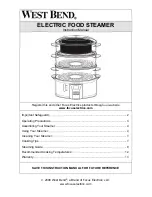
30
Make sure the heater is switched off (switch to O position), then plug into a
correctly functioning 230V-50Hz socket. Only connect the heater to an earthed
socket!
Set-up and Operation
If the heater is being used for the first time (or if you want to reset the desired
temperature), turn the thermostat dial to the maximum position (clockwise as far
as it goes).
With the mode selector dial, adjust the heater to suit your preferences.
Once the temperature in the area being heated has reached the right level, slowly
turn the thermostat dial anticlockwise until you hear a soft click; leave the dial in
that position. The heater will automatically maintain the temperature at this level.
It does this by switching the heating elements off and on when the temperature
rises or falls too much.
Note! After the thermostat has switched the heating elements off, the fan will keep
turning. This means that the air
is constantly moved, allowing the heater to accurately detect if the area is cooling
down.
The thermostat dial is continuously adjustable. A higher temperature is set by
turning it clockwise; a lower temperature by turning it anticlockwise.
Safety features
Overheating safeguard
In case of internal overheating, the overheating safeguard will switch the heater
off. If this occurs, immediately turn the mode selector dial to O, unplug and allow
heater to cool down for at least 10 minutes. In theory, the heater can now be used
as normal. There is, however, generally a reason for an appliance overheating. This
may be because the heater cannot adequately release its heat or take in fresh air
(because the heater is covered, the grills are blocked, the heater is placed too near
a wall etcetera). Before using the heater again, therefore, remove or adjust
whatever caused the appliance to overheat. If you cannot find the cause and
overheating recurs, stop using the heater and contact your vendor or a certified
electrician for inspection/repair. Overheating poses a serious fire risk!
Cleaning and Maintenance
Keep the heater clean. Deposits of dust and dirt in the appliance are a common
cause of overheating so these should be removed regularly. Switch off the heater,
remove the plug from the socket and allow the heater to cool down before cleaning
or carrying out maintenance work..
Wipe the outside of the heater regularly with a dry or slightly damp cloth. Do not
use aggressive soaps, sprays, cleaners or abrasives, waxes, polishes or chemical
solutions!
















































